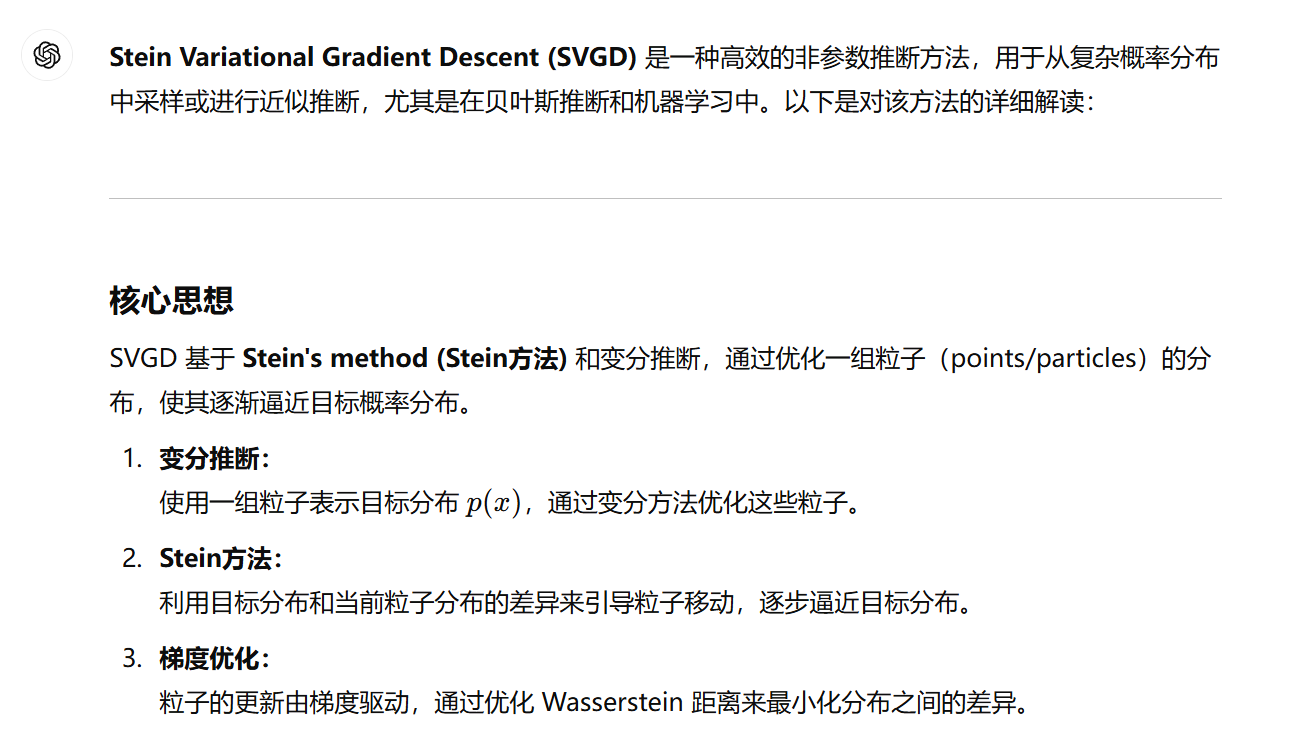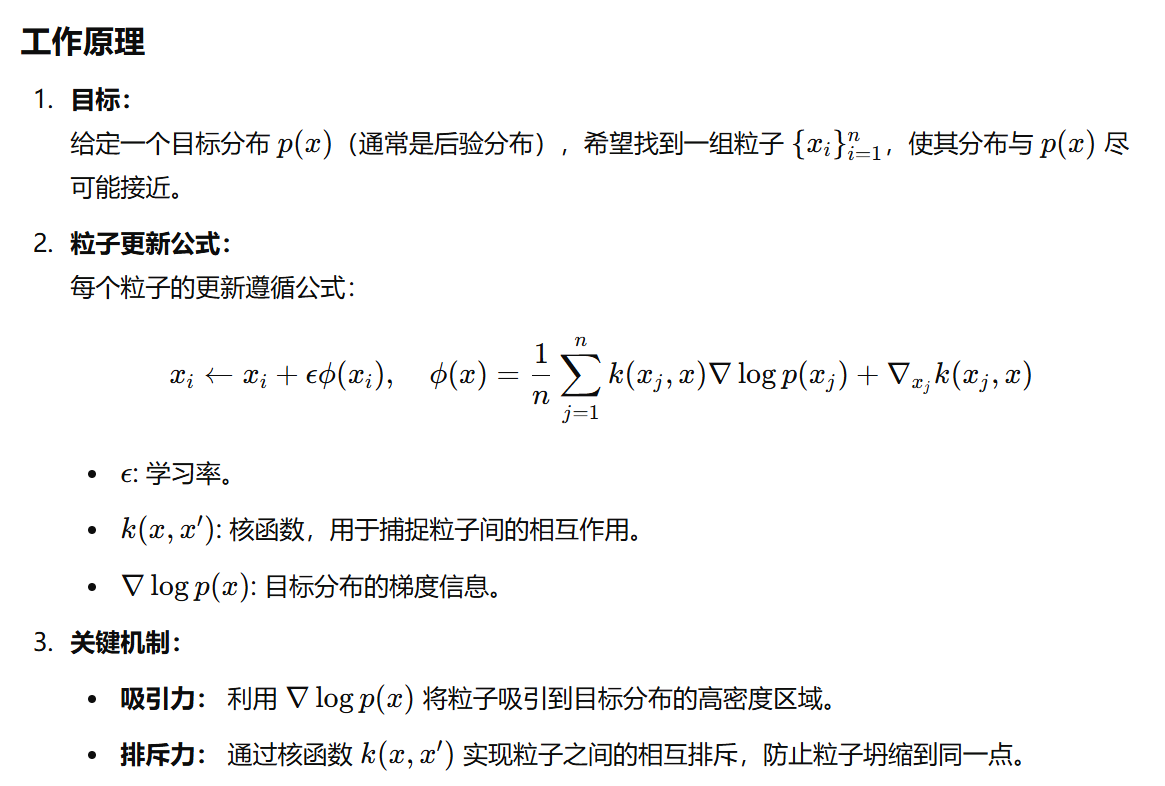强化学习SQL算法(soft q learning)—— SVGD的实现(Stein Variational Gradient Descent: A General Purpose Bayesian Inference Algorithm)
代码实现地址:
SVGD 是一种高效、灵活的推断方法,尤其适合高维度复杂分布的近似问题。
from distutils.version import LooseVersion
import numpy as np
import tensorflow as tf
def adaptive_isotropic_gaussian_kernel(xs, ys, h_min=1e-3):
"""Gaussian kernel with dynamic bandwidth.
The bandwidth is adjusted dynamically to match median_distance / log(Kx).
See [2] for more information.
Args:
xs(`tf.Tensor`): A tensor of shape (N x Kx x D) containing N sets of Kx
particles of dimension D. This is the first kernel argument.
ys(`tf.Tensor`): A tensor of shape (N x Ky x D) containing N sets of Kx
particles of dimension D. This is the second kernel argument.
h_min(`float`): Minimum bandwidth.
Returns:
`dict`: Returned dictionary has two fields:
'output': A `tf.Tensor` object of shape (N x Kx x Ky) representing
the kernel matrix for inputs `xs` and `ys`.
'gradient': A 'tf.Tensor` object of shape (N x Kx x Ky x D)
representing the gradient of the kernel with respect to `xs`.
Reference:
[2] Qiang Liu,Dilin Wang, "Stein Variational Gradient Descent: A General
Purpose Bayesian Inference Algorithm," Neural Information Processing
Systems (NIPS), 2016.
"""
Kx, D = xs.get_shape().as_list()[-2:]
Ky, D2 = ys.get_shape().as_list()[-2:]
assert D == D2
leading_shape = tf.shape(input=xs)[:-2]
# Compute the pairwise distances of left and right particles.
diff = tf.expand_dims(xs, -2) - tf.expand_dims(ys, -3)
# ... x Kx x Ky x D
if LooseVersion(tf.__version__) <= LooseVersion('1.5.0'):
dist_sq = tf.reduce_sum(input_tensor=diff**2, axis=-1, keepdims=False)
else:
dist_sq = tf.reduce_sum(input_tensor=diff**2, axis=-1, keepdims=False)
# ... x Kx x Ky
# Get median.
input_shape = tf.concat((leading_shape, [Kx * Ky]), axis=0)
values, _ = tf.nn.top_k(
input=tf.reshape(dist_sq, input_shape),
k=(Kx * Ky // 2 + 1), # This is exactly true only if Kx*Ky is odd.
sorted=True) # ... x floor(Ks*Kd/2)
medians_sq = values[..., -1] # ... (shape) (last element is the median)
h = medians_sq / np.log(Kx) # ... (shape)
h = tf.maximum(h, h_min)
h = tf.stop_gradient(h) # Just in case.
h_expanded_twice = tf.expand_dims(tf.expand_dims(h, -1), -1)
# ... x 1 x 1
kappa = tf.exp(-dist_sq / h_expanded_twice) # ... x Kx x Ky
# Construct the gradient
h_expanded_thrice = tf.expand_dims(h_expanded_twice, -1)
# ... x 1 x 1 x 1
kappa_expanded = tf.expand_dims(kappa, -1) # ... x Kx x Ky x 1
kappa_grad = -2 * diff / h_expanded_thrice * kappa_expanded
# ... x Kx x Ky x D
return {"output": kappa, "gradient": kappa_grad}
以下内容为ChatGPT自动生成,可靠性未验证,因此只作为参考之用:


下面的SVGD的计算方法和代码实现已经经过验证,真实可行。

代码实现(简单版本的实现):
import numpy as np
from scipy.stats import multivariate_normal
# 核函数(RBF kernel)
def rbf_kernel(x, y, h):
diff = x[:, None] - y[None, :]
return np.exp(-np.sum(diff**2, axis=2) / (2 * h))
# SVGD 更新步骤
def svgd_update(particles, grad_log_p, kernel_fn, learning_rate=0.01):
n = len(particles)
kernel_matrix = kernel_fn(particles, particles)
grad_kernel = -np.sum(kernel_matrix[:, :, None] * (particles[:, None] - particles[None, :]), axis=0) / len(particles)
grad_log = grad_log_p(particles)
update = (kernel_matrix @ grad_log + grad_kernel) / n
particles += learning_rate * update
return particles
# 示例目标分布:二维高斯分布
def target_grad(x):
mean = np.array([0, 0])
cov = np.eye(2)
return -np.dot((x - mean), np.linalg.inv(cov))
# 初始化粒子
particles = np.random.randn(100, 2)
# 迭代更新
for _ in range(100):
particles = svgd_update(particles, target_grad, lambda x, y: rbf_kernel(x, y, h=0.5))
print("Updated particles:", particles)
上面实现的目标分布的多维独立高斯分布均值为(0, 0),为了更明显些,修改为(10, 20),给出修改后的代码和运行结果:
import numpy as np
from scipy.stats import multivariate_normal
# 核函数(RBF kernel)
def rbf_kernel(x, y, h):
diff = x[:, None] - y[None, :]
return np.exp(-np.sum(diff**2, axis=2) / (2 * h))
# SVGD 更新步骤
def svgd_update(particles, grad_log_p, kernel_fn, learning_rate=0.01):
n = len(particles)
kernel_matrix = kernel_fn(particles, particles)
grad_kernel = -np.sum(kernel_matrix[:, :, None] * (particles[:, None] - particles[None, :]), axis=0) / len(particles)
grad_log = grad_log_p(particles)
update = (kernel_matrix @ grad_log + grad_kernel) / n
particles += learning_rate * update
return particles
# 示例目标分布:二维高斯分布
def target_grad(x):
mean = np.array([10, 20])
cov = np.eye(2)
return -np.dot((x - mean), np.linalg.inv(cov))
# 初始化粒子
particles = np.random.randn(100, 2)
# 迭代更新
for _ in range(10000):
particles = svgd_update(particles, target_grad, lambda x, y: rbf_kernel(x, y, h=0.5))
print("Updated particles:", particles)
运行结果:

本博客是博主个人学习时的一些记录,不保证是为原创,个别文章加入了转载的源地址,还有个别文章是汇总网上多份资料所成,在这之中也必有疏漏未加标注处,如有侵权请与博主联系。
如果未特殊标注则为原创,遵循 CC 4.0 BY-SA 版权协议。
posted on 2024-12-22 13:28 Angry_Panda 阅读(63) 评论(0) 收藏 举报




 浙公网安备 33010602011771号
浙公网安备 33010602011771号